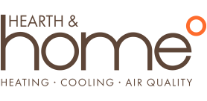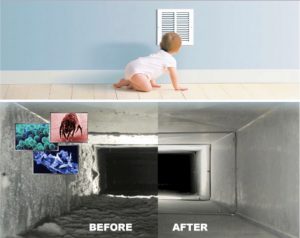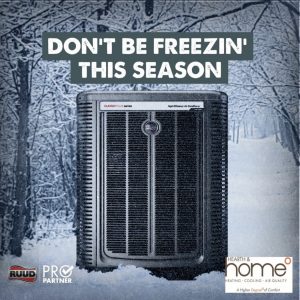UV Lights For HVAC- How Does It Work?
It may sound weird that just shining lights into your air ducts can get rid of germs, but UV lights for HVAC are really effective in improving the air quality in your home. For decades, UV lights have always come in handy where clean air quality is vital. Hospitals, laboratories, and other health facilities have benefited from using UV lights.
Likewise, other businesses like food handling businesses and water treatment plants have also accepted UV lights as a method of curbing the spread of germs. However, as much as some UV lights manufacturers make it seem like UV lights are easy to use when it comes to improving your home’s air quality, it isn’t as simple as that.
What are UV Lights for HVAC?
UV lights for HVAC can also be referred to as ultraviolet germicidal irradiation (UVGI) systems. They are germicidal lights that destroy the DNA of germs, bacteria, mold spores, fungi, and viruses that passes through your HVAC’s air handler. UV lights are very efficient as they can kill up to 99.9% of the air pollutant that passes through them.
The lights focus on microorganisms that contaminate the air such as viruses, mold spores, and bacteria. UV lights don’t affect other non-living air contaminants like pet dander, pollen, and dust. It doesn’t eliminate gaseous air pollutants either. Just like you place your clothes under the sun’s ultraviolet rays to kill the germs on the clothes, UV lights work similarly.
Furthermore, UV lights contain the same ultraviolet rays found in the sun, but the intensity is much higher than the sun’s ultraviolet ray that gets to the earth. UV light is effective in destroying the nucleic acid in microorganisms. They destroy their DNA and render them unproductive or kill them.
UV lights have been scientifically proven to destroy pathogens in the air since the 20th century. Hospitals used them to curb the spread of airborne diseases like tuberculosis. Nowadays, UV lights are very effective in destroying viruses and bacteria as well. They can kill different virus types like the influenza virus, rhinovirus, Severe Acute Respiratory Syndrome (SARS). Bacteria such as Staphylococcus aureus aren’t left out.

How Does UV Light for HVAC System Work
UV lights for HVAC systems produce a specific wavelength of ultraviolet light (254 nanometers). When microorganisms are exposed to UV light, their DNA absorbs the UV light. The UV lights don’t destroy the microorganisms instantly. Instead, it renders the microorganisms unproductive, making it difficult for them to produce the proteins that survive them. Then it shortens their life span, and they die afterward.
All UVGI Systems Don’t Work the Same Way
However, it is important to understand that improving your indoor air quality isn’t just about putting any UVGI System into your HVAC air ducts. Exposure to the right light intensity is necessary if destroying microorganisms is your intent. The effectiveness of UVGI systems depends on factors such as:
- Duct reflectivity
- The intensity of the lamps
- The position of the lamp, and
- The number of the lamp.
Additionally, while considering getting UV lights for your HVAC system, you may need to choose the type of UV light that suits your need.
Types of UV lights
Here are the various types of UV lights:
Coil Sterilization
This UV light system is very common. It’s installed close to your AC’s evaporator coil. This UV light system is designed to constantly shine in order to prevent pathogen build-up around the coil. Improved air is produced because it lessens the microbes on the evaporator coil.
Air Sterilization
This UV light system is installed in the return air duct, and its’ primary function is to get rid of microbes in the air. Unlike coil sterilization UV light system that shines constantly, it only turns on when the HVAC system is being operated. It lessens the build-up of microbes on your HVAC units by purifying the air that passes through them.
UV Light Installation
UV lights can be installed by professional HVAC technicians. They are installed in the evaporator coil of your HVAC indoor unit. The technician inspects and cleans the air handler before installing it. He inspects other parts of the HVAC system to make sure they are in good condition. He also checks for cracks and crevices within your home to prevent air leakage. This is to ensure that the efficiency of the UV lights remains intact.

Why UV Lights Are Installed In Your HVAC System
Installing UV light directly inside the home wouldn’t be ideal because air circulates. This makes it difficult for the UV light to target the contaminants. Additionally, UV lights can cause harm to humans as well. However, when UV lights are installed inside your air handler, it ensures that any living contaminant that passes through it dies.
Drawbacks of UV Lights
UV lights cannot get rid of non-living contaminants. They focus only on microorganisms. Using UV lights alone may mean that other non-living air contaminants would still be present in your home. These air contaminants reduce the effectiveness of the UV light because your indoor air would still be contaminated. UV lights work more effectively with high-quality air filters.
Are UV Lights Systems Worth The Investment?
Although UV light systems can be beneficial to you, they are not cheap to get. They also need to be maintained annually, which can cost a lot of money because the lamps have to be replaced during maintenance. The lamps become less effective in killing germs after about 1-2 years, so it becomes necessary to replace them.
Additionally, UV light systems are essential in places where clean air quality is required. You should consider whether your home needs the benefits of UV lights before you get one. If you or any member of your household has a weakened immune system, allergies, respiratory condition, or chronic obstructive pulmonary disease, getting UV lights can pay off.
Also, UVGI systems are helpful in more crowded areas. If you have a large family, consider getting a UV light to help limit the spread of airborne diseases, especially during the winter season.
Endnote
There you have it! Above is a breakdown of what UV lights for HVAC are and how they work. UV lights are highly effective in destroying the DNA of germs, bacteria, mold spores, fungi, and viruses that passes through your HVAC’s air handler. However, these UVGI systems only target a limited range of air contaminants. You will still need to get an efficient air filter to capture other air contaminants like dust, pollen, and pet dander. With this combination, you are sure to get improved air quality in your home.




